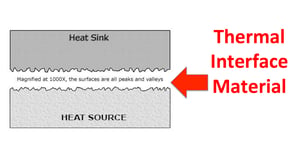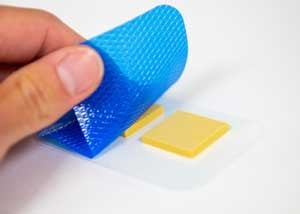 Thermal gap pads are one common type of thermal management materials and are utilized in electronic devices within the interface, or gap, between a heat generating component and a heat sink. The heat sink or cooling plate is designed to conduct heat away from the heat generating component to keep it cool and running safely.
Thermal gap pads are one common type of thermal management materials and are utilized in electronic devices within the interface, or gap, between a heat generating component and a heat sink. The heat sink or cooling plate is designed to conduct heat away from the heat generating component to keep it cool and running safely.
According to Parker Chomerics Thermal Management Engineering Handbook, the typical contact area between most semiconductors and heat sinks can be made up of 90% air voids! We also know that air is about 200 times less conductive than a 5 W/mK thermal interface pad. This is where the thermal gap pad comes in.
Thermal gap pads are made of soft polymer that flows into the air gaps in the interface to aid in the more efficient and effective conduction of heat.
Thermal Pad Product Constructions - What Are Thermal Gap Pads Made Of?
 SILICONE: The base polymer of the vast majority of thermal gap pad products is silicone for various reasons:
SILICONE: The base polymer of the vast majority of thermal gap pad products is silicone for various reasons:
-
- Withstands high temperatures
- Its chemical or molecular structure is such that dispersion of fillers can be even and predictable
- Can be made soft and pliable
- Has good dielectric strength
ACRYLIC: There are a few thermal gap pad materials on the market now that are made of an acrylic polymer. While acrylic is less expensive than most silicone varieties, by comparison they are…
-
- Lower in thermal conductivity (higher in thermal resistance)
- Unable to be made as soft as silicone
- Unable to withstand high temperatures (good to about 212°F)
- Unable to be made as thick as silicone
FILLERS: The actual thermally conductive filler used in thermal gap pads is almost always proprietary. They can include ceramic powders, aluminum oxide, and boron nitride.
CARRIER / SUPPORT LAYER:
- A carrier or reinforcing layer is often included to give the material higher tensile strength, dimensional stability, dielectric strength, and puncture resistance.
- Woven fiberglass is a very common supporting layer. The weave is open enough that the silicone compounds penetrate through the fabric.
- Other available layers include aluminum foil, and polyimide or Kapton.
Manufacturers: Polymer Science, 3M, Saint-Gobain, Rogers Corporation, Parker Chomerics
There are a handful thermal pad material manufacturers that we would like to highlight. Marian is a Preferred Converter for these manufacturers. Our preferred status gives us some advantages that we share with our customers. Such as…

- Preferred pricing
- Cooperative efforts in sales, engineering and product development
- Advanced exposure to new product launches
- Technical training
- Thermal interface material expertise
What We Like to Know Before Recommending a Thermal Gap Pad Material:
When looking for a thermal gap pad material, Marian Sales Engineers have been trained to help you find your way through the maze of choices. Begin with the considerations below:
- THICKNESS OF THE GAP - Start with the thickness of the gap. When it comes to a Thermal Gap Pad, thinner is better as long as the pad closes out all of the air pockets.
- RELATIVE TEXTURE OF SURFACES - No surface is perfect. Extremely rough or serrated surfaces will need compensation thickness and hardness of the gap pad.
- AMOUNT OF CLAMPING FORCE AVAILABLE - If only minimal clamping force is possible, an extremely soft pad material may be needed.
- AREA OR SIZE OF THE HEAT SINK / COOLING PLATE - The geometry of the area of the pad and heat sink affect cooling effectiveness of the gap pad. This will also help us recommend a material with a reinforcing layer if necessary.
- THERMAL IMPEDANCE / RESISTANCE THAT IS TOLERABLE - Impedance is application specific. If you know the impedance values needed for your components, we can be sure to recommend a material that has adequate conductance. If it is not known, we can help set a target value and then adjust as needed through testing and evaluation.
- OTHER CONSIDERATIONS
- Dielectric Constant
- Specific Gravity
- Volume Resistivity
- Operating Temperature Range
- Flammability
- Carrier / Reinforcing Layer
- Availability & Cost
Trying to Increase Thermal Conductivity In Your Application?
There are only 3 things you can do, and they may be done in combination:-
- Increase Thermal Conductivity (W/mK) of your gap pad.
- Reduce the thickness of your gap and gap pad (while still closing off all air pockets)
- Increase the geometry (size) of your heat sink or cooling plate
Put Marian to Work for YOU
Experienced Marian Representatives can help you navigate all of the choices and possibilities, providing samples, data, technical support from manufacturers, prototypes, and assembly recommendations.
Other Thermal Management Material Resources:





